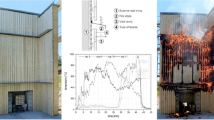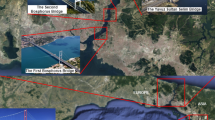Abstract
Health state of shield tunnels is one of the most important parameters for structure maintenance. Usually, the shield tunnel is extremely long in longitude direction and composed by many segments. It is difficult to quantify the relationship between the structure damage state and shield tunnel structure deformation by the model test because of unpredictable effects of different scales between model test and prototype tunnel structure. Here, an in-situ monitoring project was conducted to study the excavation induced shield tunnel structure damage, which could be considered a prototype test on the tunnel deformation. The disaster performance of tunnel leakage, segment crack, segment dislocation and segment block drop-off during longitude deformation and cross-section ovality developments was analyzed. The results indicate that instead of the longitude deformation, the ovality value has the strongest correlation to the rest disease performance, which could be used as the assessment index of the tunnel health. For this tunnel, it is in health state when the ovality is less than 0.5%, and the serious damage could be found when the ovality value is higher than 0.77%. The research results provide valuable reference to shield tunnel health assessment and help complete the standard of shield tunnel construction.
摘要
结构变形是隧道结构性能评估的重要依据,然而由于隧道结构具有纵向线性、横向截面大的特 点,难以通过室内模型试验或者远行试验来研究结构变形与结构损伤的关系。以长三角某单圆盾构法 错缝隧道事故案例为依托,通过研究结构变形、管片裂缝、接缝变形等病害特点及与隧道截面椭圆度 的相关性,综合分析了隧道病害类型及检测方法。研究结果表明,椭圆度与各隧道病害指标均表现出 很强的相关性,可以用来描述隧道病害程度的重要指标。若椭圆度小于0.5%,则隧道可以被认为处 于完全健康的状态。但是如果椭圆度超过0.77%,则隧道处于严重的破坏状态。成果对完善盾构隧道 相关规范,以及对形成运营期隧道维修养护标准有重要的意义。
Similar content being viewed by others
References
Jiang Man, Li Hai-ying, Xu Xin-yue, Xu Shi-peng, Miao Jian-rui. Metro passenger flow control with stationto-station cooperation based on stop-skipping and boarding limiting [J]. Journal of Central South University, 2017, 24(1): 236–244. DOI: 10.1007/s11771-017-3424-x.
Yang Xiao-li, Li Zheng-wei, Liu Zheng-an, Xiao Hai-bo. Collapse analysis of tunnel floor in karst area based on Hoek-Brown rock media [J]. Journal of Central South University, 2017, 24(4): 957–966. DOI: 10.1007/s11771-017-3498-5.
Koyama Y. Present status and technology of shield tunneling method in Japan [J]. Tunnelling and Underground Space Technology, 2003, 18(2, 3): 145–159. DOI: 10.1016/S0886-7798(03)00040-3.
Lei M, Peng L, Shi C, Wang S. Experimental study on the damage mechanism of tunnel structure suffering from sulfate attack [J]. Tunnelling and Underground Space technology, 2013, 36: 15–13. DOI: 10.1016/j.tust.2013. 01.007.
Montero R, Victores J G, Martinez S, Jardon A, Balaguer C. Past, present and future of robotic tunnel inspection [J]. Automation in Construction, 2015, 59: 99–112. DOI: 10.1016/j.autcon.2015.02.003.
Ni Y Q, Ye X W, Ko J M. Monitoring-based fatigue reliability assessment of steel bridges: analytical model and application [J]. Journal of Structural Engineering, 2010, 136(12): 1563–1573. DOI: 10.1061/(ASCE)ST.1943-541X. 0000250.
Feng L, Yi X, Zhu D, Xie X, Wang Y. Damage detection of metro tunnel structure through transmissibility function and cross correlation analysis using local excitation and measurement [J]. Mechanical Systems and Signal Processing, 2015, 60–61: 59–74. DOI: 10.1016/j.ymssp.2015. 02.007.
Shi C, Cao C, Lei M. An analysis of the ground deformation caused by shield tunnel construction combining an elastic half-space model and stochastic medium theory [J]. KSCE Journal of Civil Engineering, 2017, 21(5): 1933–1944. DOI: 10.1007/s12205-016-0804-y.
Chen C S, Liu Y C. A methodology for evaluation and classification of rock mass quality on tunnel engineering [J]. Tunnelling and Underground Space Technology, 2007, 22(4): 377–387. DOI: 10.1016/j.tust.2006.10.003.
Yazdani-Chamzini A, Yakhchali S H. Tunnel boring machine (TBM) selection using fuzzy multicriteria decision making methods [J]. Tunnelling and Underground Space Technology, 2012, 30: 194–204. DOI: 10.1016/j.tust. 2012.02.021.
Zhang W, Sun K, Lei C, Zhang Y, Li H, Spencer B F. Fuzzy analytic hierarchy process synthetic evaluation models for the health monitoring of shield tunnels [J]. Computer-Aided Civil and Infrastructure Engineering, 2014, 29(9): 676–688. DOI: 10.1111/mice.12091.
Luo Y, Chen J, Wang H, Sun P. Deformation rule and mechanical characteristics of temporary support in soil tunnel constructed by sequential excavation method [J]. KSCE Journal of Civil Engineering, 2017, 21(6): 2439–2449. DOI: 10.1007/s12205-016-0978-3.
Sharma J S, Hefny A M, Zhao J, Chan C W. Effect of large excavation on deformation of adjacent MRT tunnels [J]. Tunnelling and Underground Space Technology, 2011, 16(2): 93–98. DOI: 10.1016/S0886-7798(01)00033-5.
Bhalla S, Yang Y W, Zhao J, Soh C K. Structural health monitoring of underground facilities–Technological issues and challenges [J]. Tunnelling and Underground Space Technology, 2005, 20(5): 487–500. DOI: 10.1016/j.tust.2005. 03.003.
He M C, E Sousa R L, Muller A, Vargas E, Sousa L R, Xin C. Analysis of excessive deformations in tunnels for safety evaluation [J]. Tunnelling and Underground Space Technology, 2015, 45: 190–202. DOI: 10.1016/j.tust.2014. 09.006.
Wang Z, Shen L, Xie J, Yao J. Structure analysis for tunnel longitudinal deformation based on segment dislocation mode [J]. Procedia Engineering, 2012, 31: 487–491. DOI: 10.1016/j.proeng. 2012.01.1056.
Chen G Q, Huang R Q, Xu Q, Li T B, Zhu M L. Progressive modelling of the gravity-induced landslide using the local dynamic strength reduction method [J]. Journal of Mountain Science, 2013, 10(4): 532–540. DOI: 10.1007/s11629-013-2367-4.
Wang Z, Wang L Z, Wang J C, Li L L. Case study of rehabilitation of a damaged underwater tunnel in the construction phase [J]. Journal of Performance of Constructed Facilities, 2014, 30(1): C4014003. DOI: 10.1061/(ASCE)CF.1943-5509.0000648.
Peng J B, Huang Q B, Hu Z P, Wang M X, Li T, Men Y M, Fan W. A proposed solution to the ground fissure encountered in urban metro construction in Xi’an, China [J]. Tunnelling and Underground Space Technology, 2017, 61: 12–25. DOI: 10.1016/j.tust.2016.09.002.
Shirlaw J N. Observed and calculated pore pressures and deformations induced by an earth balance shield: Discussion [J]. Canadian Geotechnical Journal, 1995, 32(1): 181–189. DOI: 10.1139/t95-017.
Cooper M L, CHAPMAN D N, ROGERS C D F, CHAN A H C. Movements in the Piccadilly Line tunnels due to the Heathrow Express construction [J]. Géotechnique, 2002, 52(4): 243–257. DOI: 10.1680/geot.2002.52.4.243.
Mair R J. Tunnelling and geotechnics: New horizons [J]. Géotechnique, 2008, 58(9): 695–736. DOI: 10.1680/geot. 2008.58.9. 695.
Wongsaroj J, Soga K, Mair R J. Modelling of long-term ground response to tunnelling under St James's Park, London [J]. Géotechnique, 2007, 57(1): 75–90. DOI: 10.1680/ssc.41080.0023
Xie X Y, Li P. GPR identification of voids inside concrete based on the support vector machine algorithm [J]. Journal of Geophysics and Engineering, 2013, 10(3): 034002. DOI: 10.1088/1742-2132/10/3/034002.
Zhang D M, Ma L X, Zhang J, Hicher P Y, Juang C H. Ground and tunnel responses induced by partial leakage in saturated clay with anisotropic permeability [J]. Engineering Geology, 2015, 189: 104–115. DOI: 10.1016/j.enggeo.2015.02.005.
Shi C, Cao C, Lei M, Peng L, Ai H. Effects of lateral unloading on the mechanical and deformation performance of shield tunnel segment joints [J]. Tunnelling and Underground Space Technology, 2016, 51: 175–188. DOI: 10.1016/j.tust.2015.10.033.
Author information
Authors and Affiliations
Corresponding author
Additional information
Foundation item: Projects(BK20150337, BK20140845, BK20140844) supported by the Natural Science Foundation of Jiangsu Province, China; Project(2015Y04) supported by the Transportation Science and Technology Project of Jiangsu Province, China; Project(41504081) supported by the National Natural Science Foundation of China; Projects(2014M561567, 2016T90416) supported by the China Postdoctoral Science Foundation
Rights and permissions
About this article
Cite this article
Li, P., Zhang, Yw., Jiang, Fy. et al. Comprehensive health assessment of shield tunnel structure based on prototype experiment. J. Cent. South Univ. 25, 681–689 (2018). https://doi.org/10.1007/s11771-018-3771-2
Received:
Accepted:
Published:
Issue Date:
DOI: https://doi.org/10.1007/s11771-018-3771-2




